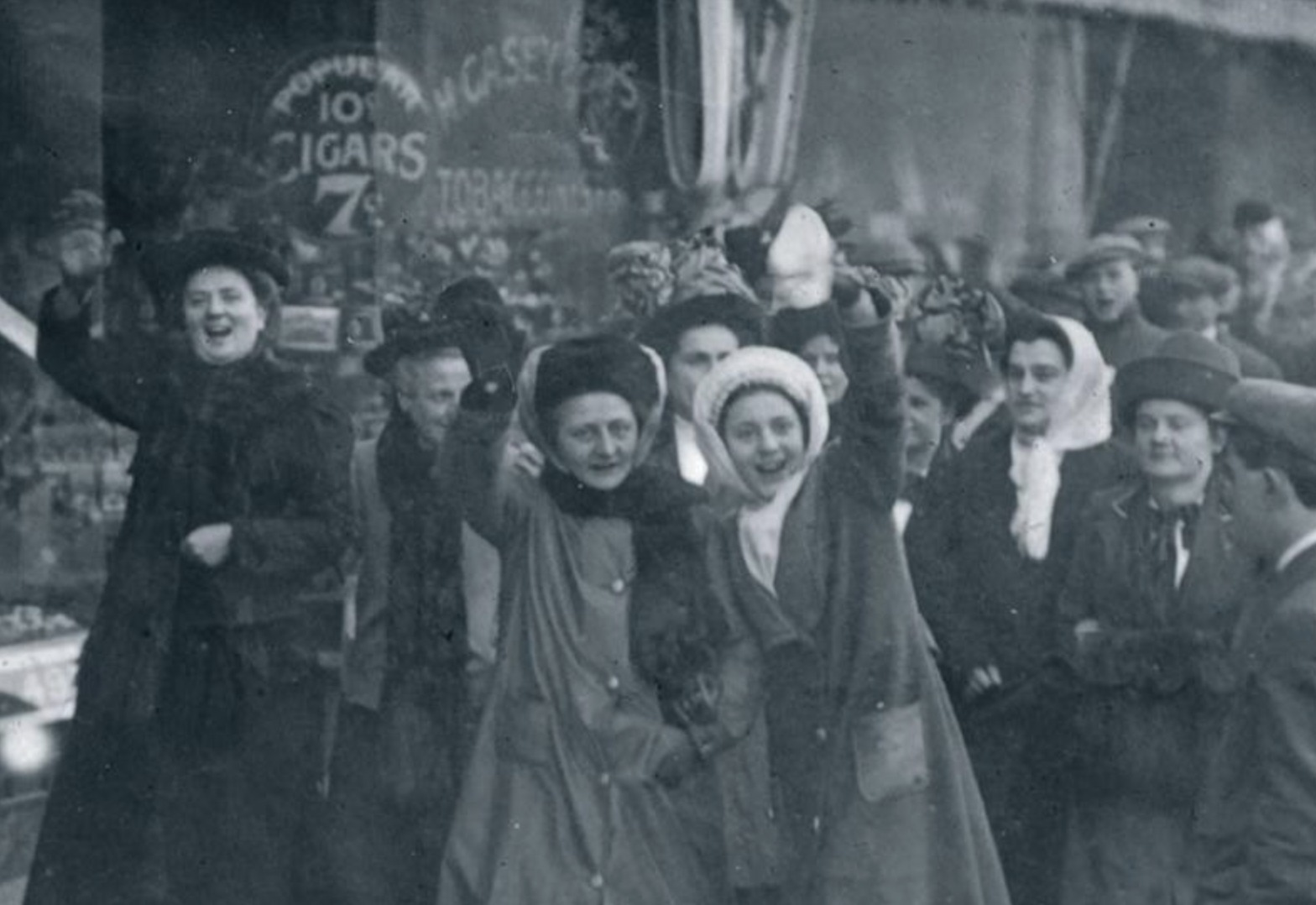In both Turkish and global leftist literature, the history of “March 8th” is traced back to a strike by female textile workers in New York City, USA on March 8, 1857. The story goes that during this strike, a fire broke out and the employer locked the factory doors, resulting in the deaths of 129 women workers.
However, there is no mention of a strike on March 8, 1857 (which fell on a Sunday) in the American press. Furthermore, there is no reference to this event in any literature on American labor history or feminist narratives.
So, do we have any information about the “women who died in the fire”? Yes, on March 25, 1911, a fire broke out at the Triangle Shirtwaist Factory in New York, killing 146 workers, 123 of whom were women.
In essence, the widely accepted history of March 8th is based on a myth that conflates two events, one that did not happen and one that did.
The fact that even I, someone who claims to do “alternative history,” was susceptible to this misinformation about the origins of March 8th reminded me of the importance of the book “The Invention of Tradition” by Eric Hobsbawm and Terence Ranger, British Marxists, published in 1983 and translated into Turkish by Agora Kitaplığı in 2006 as “Geleneğin İcadı.”
So, was it a “French Communist invention”?
Tracing the origins of this myth reveals some interesting details. The first mention of the “March 8, 1957 strike” narrative appears in an article by Victor Michaut in the March 4, 1950 issue of Cahiers du Communisme, the theoretical journal of the French Communist Party (PCF):
“The American Socialist Party, at its 1908 Congress, decided to dedicate every last Sunday of February to women’s suffrage and the spread of socialist slogans among women (…). This first celebration was particularly commemorated in New York, on February 27, 1909, in the United States.”
Note that this article mentions a commemoration on February 27, not March 8. Indeed, from 1909 onwards, American working women celebrated a kind of Women’s Day every year in the last week of February. (Some sources say February 28th, but I gathered from newspapers that it didn’t always fall on that date.)
On March 13, 1955, L’Humanité Dimanche, the Sunday edition of the PCF’s daily newspaper L’Humanité, added new details to the story in the form of a fable (which slightly contradicts the first text):
“Once upon a time, in 1857, there were garment workers in New York. They worked ten hours a day in the appalling conditions of starvation wages. Something was born out of their anger, their misery…”
Two years later, on March 7, 1957, L’Humanité further embellished the myth with new details:
“On March 8, 1857, the garment workers of New York were tired of working from the first light of dawn. They left the stalls that served as workshops at a very late hour of the night, which provided the threads, needles and sometimes the machines, and took to the streets like men carrying placards and banners. This event added to the working world […] our old Europe, where we tell the children the story of the Goliaths and the fathers tell their sons the story of the barricades of March 8 in New York. The memory of this March 8th remained so alive in the minds of the workers that it became the date proposed by the great German socialist activist Clara Zetkin at the Copenhagen Conference in 1910 for an international women’s day.”
After this date, the myth spread like wildfire. No one questioned it, but rather amplified it. Indeed, we see this story repeated in the first issue of Antoinette, the women’s newspaper of the Confédération générale du travail (CGT-General Confederation of Labor), which was influenced by the PCF, in March 1964. In the March 1966 issue, Antoinette declares: “March 8, International Women’s Day, is a ‘day of hope, a day of struggle for our sisters around the world’.”
Klara Zetkin and friends
We will find the answer to this question in the real history of March 8, International Women’s Day (later International Women’s Day, then International Working Women’s Day, now simply Women’s Day). For this, we need to turn not to the United States, but to the history of the German socialists.
When we look at the approach to the women’s question of the women delegates to the Second International, the International Workers’ Union, founded in Paris in 1889, we see that they were clearly concerned with the problems of working women. One of the women delegates stands out for her active work at the congress. This woman was Klara Zetkin, the representative of the German Women Workers’ Union. According to Klara, who presented a report to the congress entitled “For the Liberation of Women!” and those who defended her views at the congress, the bourgeois woman, while raising the demand for independent, free disposal of her own property against her husband, turns her back on the struggle of working women to throw off the yoke of exploitation. Therefore, the struggle is not just for women’s rights, it is part of the class struggle.
On August 19, 1907, at the First International Socialist Women’s Conference in Stuttgart, there were long discussions on the women’s question. According to the decision of the conference, the International Socialist Women’s Secretariat was established and Klara Zetkin was appointed as its head. Klara would hold this position until 1917. As you can guess, the women’s struggle is again a sub-heading of the class struggle. Let me leave the critique of this approach for another time and try to convey the situation of working women with a narrative from this land.
In his 1909 story “Hakk-ı Sükut” (The Price of Silence), Refik Halit (Karay) describes the working conditions of female workers in the silk factories of Bursa:
“For three or four piastres, they toil for fourteen hours by the boiling water, inhaling foul odors and sick breaths, their bodies becoming emaciated, losing a bit of their freshness, youth, and sparkle in their eyes every day. (…) Those who come joyfully, cheerful and strong, with their silk hair adorned with red ribbons, after a year or two drag their weak feet and their clunky clogs with difficulty on the cobblestones to their huts. They had only six hours to rest their aching heads and burning chests; not for laughing and talking! Who knows with what difficulty these sick and tired eyes open the next morning, and how these poor bodies, each bone aching, are roused to the factory whistle? Who knows how many tears these sickly mornings shed, how difficult it was to drag these frail bodies?”
It is not difficult to imagine that the female silk workers of Bursa did not have a very different status from the girls working in the Triangle Shirtwaist Factory in New York. In fact, the demands of the 100 women delegates who attended the Second International Women’s Conference in Copenhagen on August 26-27, 1910, representing trade unions, socialist parties, and working women’s clubs from 17 countries, included an eight-hour workday for women workers, eight weeks of maternity leave before childbirth for pregnant women, nursing breaks for breastfeeding women, a ban on child labor under the age of 12, social security for unemployed women, and the right to vote for women.
The First “March” Celebrations
Let me emphasize that in 1910, there was no mention by socialist women of the 1857 strike or the women who died in the fire. However, Clara Zetkin proposed a women’s day every year during the “May Day” celebrations. Ultimately, March was chosen, the month of the German Revolution in Berlin in 1848 and the Paris Commune in 1871.
The first International Women’s Day, celebrated on March 19, 1911, was a great success story, especially in Germany and Austria. In Berlin alone, forty-two meetings were held simultaneously and more than 30,000 women marched through the streets of Vienna. (There was no socialist women’s group in France at the time that could take this initiative, so no demonstrations took place in Paris before 1914.)
The Bread and Roses Strike
Let’s return to the New World. While American socialists trace the history of Women’s Day, celebrated on the last Sunday of February since 1909, back to the struggle of Elizabeth Cady Stanton and Lucretia Mott, who convened a “women’s rights congress” in New York in 1848 and spoke against slavery, another event of great significance for the world’s working women would take place in the United States about 10 months after the New York Triangle Shirtwaist Factory fire on March 25, 1911, which I mentioned earlier as part of the “8 March 1857 myth.” This was the magnificent women’s resistance that would go down in history as the “Bread and Roses Strike.”
The Lawrence Textile Factory in Massachusetts, where the strike would take place, was the largest textile factory in the world, employing workers from forty different nations. A textile giant, Lawrence single-handedly directed a significant portion of the textile industry in the United States. On January 1, 1912, a new labor law in the United States reduced the weekly working hours for women and child workers from 56 to 54. The workers, who were already struggling to survive under very harsh working conditions, were pleased with this. Even this small legal improvement was of great value to them. However, two weeks later, Polish workers in the factory realized that their wages had been reduced by 3.5% in exchange for the reduction in weekly working hours. A wave of anger spread among the workers. The Polish workers’ first reaction was to walk out and march. The date was January 11, 1912. The next day, workers at the Washington Mill, a wool company, saw that the same deduction had been made from their wages. Seeing that the practice was also in place in other Lawrence workshops, Lawrence workers began to stop work there as well. Soon the strike spread to all Lawrence factories. The workers quickly formed committees. A main committee of 56 people, consisting of workers from 14 nations, took over all responsibility for the strike. The slogan chosen by the striking women workers was “Bread & Roses.”
A parenthesis: This strike was also the subject of a 2000 movie of the same name by the British socialist director Ken Loach. “We want bread, but we also want roses/We want all the good things, everything that is beautiful in life/ Do you see that banner? /That banner is from 1912/…, say the strikers in the movie and continue: “In Lawrence, Massachusetts, 10,000 immigrant workers, mostly women, were forced to fight against low wages. It was a long and violent struggle. But you know what happened? They won. They won. They won, okay? Nobody gives you roses for nothing. Nobody ever. When do they give you roses? When you stop begging and get organized!”
Footsteps of Revolution in Russia
Let’s leave the movie behind for now and go back in time. While labor movements were gaining momentum in America and Europe during the First World War, which began in 1914, something was also happening in Russia.
On March 8, 1917 (February 23, 1917, according to the Old Russian Julian calendar), Petrograd textile worker women suddenly went on strike in all workplaces. It turned into a city-wide resistance. This was the spark of the famous February Revolution, which would start against the Tsarist regime in Russia. The strike would be followed by the February Revolution, which would then pave the way for the October Revolution of 1917.
After the October Revolution of 1917, the newly established Soviet Union tried to preserve and advance all the women’s rights that had been gained up to that point. In 1922, referring to the resistance of the Petrograd women workers, March 8 (which was February 23 according to the Julian calendar) was officially declared International Working Women’s Day. (After 1918, Soviet Russia abandoned the Julian calendar and adopted the Gregorian calendar.)
After this date, March 8 continued to be celebrated as International Working Women’s Day of Solidarity and Struggle, primarily in socialist countries. However, it was not celebrated in capitalist countries.
What was the intention of the French communists?
Now is the right time to answer the question of why the myth of March 8, 1857 was fabricated. (I don’t know whether you will agree or not.) As you may recall, I said that the inventor of the myth of March 8, 1857 was the French Communist Party and the French Labor Union. Although the debate on “humane communism” that started in the USSR with Khrushchev’s report of 1956 after Stalin’s death had not yet found its full response in the FKP, the French communists probably wanted to base International Women’s Day on a date older than Soviet history, older than Bolshevism, and on a more spontaneous international origin rather than a congress resolution or the initiative of socialist women’s organizations. However, since their “mythical date of March 8, 1857” coincided with the birth year of Klara Zetkin, the legendary leader of the socialist women’s movement, and since the month of March coincided with the Paris Commune, they retained ties to tradition. The 8th of March was probably a nod to the February Revolution in Russia. But whatever their intentions, they have left a “tragic” “myth” for today, when the labor or feminist women’s movement already had a “real” history of “resistance” that did not need myths…
The First 8th of March Celebration in Turkey
The Story by Two Communist Women, Rahime Selimova and Cemile Nuşirvanova:
“It was February 1921. The Communist Party of Turkey, which had been active since 1919, had grown stronger and established ties with the Communist International in Moscow. It had formed cells in many cities in Anatolia. In late February, we received a directive signed by Klara Zetkin, a comrade from the Women’s Section of the Comintern, on how to celebrate International Women’s Day on March 8th. According to the directive, the focus in capitalist countries should be on women demanding their basic human rights.
In Ankara, the number of unemployed women was increasing. Turkish women who had lost their husbands and sons in the war for years were living in very difficult conditions. Finding a job was impossible. After years of war, the Entente powers had occupied Istanbul and the western and southern regions of Anatolia in an attempt to completely destroy Turkey. The Grand National Assembly Government established in Ankara during the War of Independence was continuing the fight against foreign enemies with the help of Great Lenin.
At that time, Turkish women were carrying weapons and military supplies from the Black Sea coast to Ankara. These women stood against the enemy with their husbands, sons, and brothers. But they had no social rights at that time. Nevertheless, they listened to their conscience and joined the defense of the homeland.
The only organization that recognized the human and social rights of Turkish women was the Communist Party. In early 1921, Mustafa Suphi and 14 of his comrades were brutally drowned in the Black Sea by the Turkish bourgeoisie. This event was met with deep hatred. In addition, 18 members of the central Communist organization in Ankara were imprisoned. Such tragic events deeply saddened us, the Communist women.
Aimed at protesting the bourgeois executioners on the one hand and demanding the alleviation of the difficult situation of unemployed women on the other hand, a general meeting of women was held in the vineyard of Communist comrade Süleyman Selim near Ankara. The importance of International Women’s Day on March 8th was explained in the statement by Comrade Şerif Manatov. As a second issue, a women’s organization was chosen to improve the situation of women and provide them with jobs. The previously prepared statute was approved. Then, a statement was sent to the Grand National Assembly on behalf of Turkish Women, protesting the atrocities against the Communists, Mustafa Suphi, and his friends.
The first 8th of March celebration of the women’s organization in Ankara holds an honorable place in the pages of the history of the Turkish Communist movement.” (Cited in: Türkiye’de Sol Akımlar-I (1908-1925), Documents 2, p. 513, BDS Yayınları, 1991.)
IKD revives tradition
To be honest, I have not seriously researched whether there were any March 8 celebrations after 1921 within the borders of the country we call Turkey today. But as someone who had the opportunity to work in the Progressive Women’s Association (İKD), which was founded in 1975 within the Historical TKP, I am witness to the fact that the İKD, which saw the women’s struggle as part of the working class struggle following tradition, had nearly 15 thousand members, 33 branches, 35 representative offices, and a circulation of 35 thousand copies of its publication Kadınların Sesi (Women’s Voice) under the leadership of dear Berin Uyar, celebrated March 8 in a manner befitting its “glorious history”. I also know that after the IKD was shut down by the military coup of September 12, 1980, no celebrations could be held for four years. However, happily, the celebrations of Working Women’s Day resumed in 1984… In the following years, “March 8” continued to be celebrated as “International Working Women’s Day” or “International Women’s Day” by various women’s organizations.
UN intervention
Although it seems to us that there are different interpretations of the socialist movement and the feminist movement in the background of these nomenclatures, the first crossroads occurred in 1975 when the UN General Assembly declared that year as the “Year of Women”. The UN, which we know very well what it stands for, was drawing the attention of governments in many countries around the world to the issue of discrimination against women, to which there was no objection. (Although I never found out the attitude of the USSR delegate.) In 1977, the UN General Assembly approved Resolution 32/142, inviting participating countries to celebrate International Women’s Rights Day. In 1979, the UN General Assembly ratified the Convention on the Elimination of All Forms of Discrimination against Women by 150 countries. Thus, “March 8” was detached from labor history. Of course, the acceptance of this change was related to the material conditions that gave strength to the feminist movement.
Note: By a happy coincidence, my first program on Özgürüz Radio coincided with March 8, 2019. This text is a slightly improved, slightly revised version of the text I prepared for that program. Since that day, I have repeatedly emphasized the inaccuracy of the narrative of “129 women workers who died in the fire on March 8, 1857”, and there are certainly others who have done so, but I would like to pay special tribute to Yusuf Nazım





